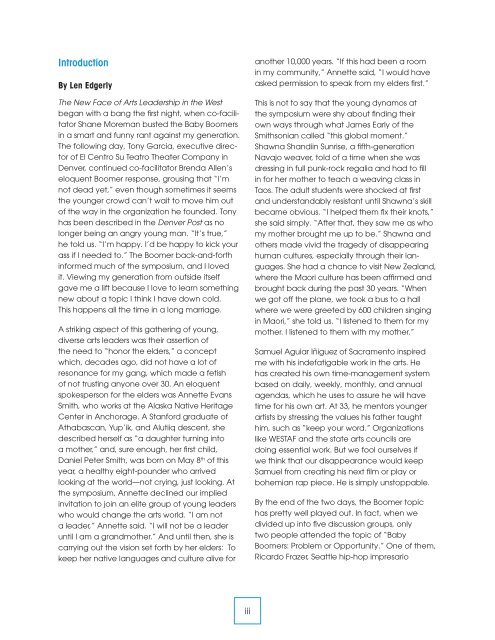The New Face of Arts Leadership in the West - westaf - The Western ...
The New Face of Arts Leadership in the West - westaf - The Western ...
The New Face of Arts Leadership in the West - westaf - The Western ...
Create successful ePaper yourself
Turn your PDF publications into a flip-book with our unique Google optimized e-Paper software.
Introduction<br />
By Len Edgerly<br />
<strong>The</strong> <strong>New</strong> <strong>Face</strong> <strong>of</strong> <strong>Arts</strong> <strong>Leadership</strong> <strong>in</strong> <strong>the</strong> <strong>West</strong><br />
began with a bang <strong>the</strong> first night, when co-facilitator<br />
Shane Moreman busted <strong>the</strong> Baby Boomers<br />
<strong>in</strong> a smart and funny rant aga<strong>in</strong>st my generation.<br />
<strong>The</strong> follow<strong>in</strong>g day, Tony Garcia, executive director<br />
<strong>of</strong> El Centro Su Teatro <strong>The</strong>ater Company <strong>in</strong><br />
Denver, cont<strong>in</strong>ued co-facilitator Brenda Allen’s<br />
eloquent Boomer response, grous<strong>in</strong>g that “I’m<br />
not dead yet,” even though sometimes it seems<br />
<strong>the</strong> younger crowd can’t wait to move him out<br />
<strong>of</strong> <strong>the</strong> way <strong>in</strong> <strong>the</strong> organization he founded. Tony<br />
has been described <strong>in</strong> <strong>the</strong> Denver Post as no<br />
longer be<strong>in</strong>g an angry young man. “It’s true,”<br />
he told us. “I’m happy. I’d be happy to kick your<br />
ass if I needed to.” <strong>The</strong> Boomer back-and-forth<br />
<strong>in</strong>formed much <strong>of</strong> <strong>the</strong> symposium, and I loved<br />
it. View<strong>in</strong>g my generation from outside itself<br />
gave me a lift because I love to learn someth<strong>in</strong>g<br />
new about a topic I th<strong>in</strong>k I have down cold.<br />
This happens all <strong>the</strong> time <strong>in</strong> a long marriage.<br />
A strik<strong>in</strong>g aspect <strong>of</strong> this ga<strong>the</strong>r<strong>in</strong>g <strong>of</strong> young,<br />
diverse arts leaders was <strong>the</strong>ir assertion <strong>of</strong><br />
<strong>the</strong> need to “honor <strong>the</strong> elders,” a concept<br />
which, decades ago, did not have a lot <strong>of</strong><br />
resonance for my gang, which made a fetish<br />
<strong>of</strong> not trust<strong>in</strong>g anyone over 30. An eloquent<br />
spokesperson for <strong>the</strong> elders was Annette Evans<br />
Smith, who works at <strong>the</strong> Alaska Native Heritage<br />
Center <strong>in</strong> Anchorage. A Stanford graduate <strong>of</strong><br />
Athabascan, Yup’ik, and Alutiiq descent, she<br />
described herself as “a daughter turn<strong>in</strong>g <strong>in</strong>to<br />
a mo<strong>the</strong>r,” and, sure enough, her first child,<br />
Daniel Peter Smith, was born on May 8 th <strong>of</strong> this<br />
year, a healthy eight-pounder who arrived<br />
look<strong>in</strong>g at <strong>the</strong> world—not cry<strong>in</strong>g, just look<strong>in</strong>g. At<br />
<strong>the</strong> symposium, Annette decl<strong>in</strong>ed our implied<br />
<strong>in</strong>vitation to jo<strong>in</strong> an elite group <strong>of</strong> young leaders<br />
who would change <strong>the</strong> arts world. “I am not<br />
a leader,” Annette said. “I will not be a leader<br />
until I am a grandmo<strong>the</strong>r.” And until <strong>the</strong>n, she is<br />
carry<strong>in</strong>g out <strong>the</strong> vision set forth by her elders: To<br />
keep her native languages and culture alive for<br />
ano<strong>the</strong>r 10,000 years. “If this had been a room<br />
<strong>in</strong> my community,” Annette said, “I would have<br />
asked permission to speak from my elders first.”<br />
This is not to say that <strong>the</strong> young dynamos at<br />
<strong>the</strong> symposium were shy about f<strong>in</strong>d<strong>in</strong>g <strong>the</strong>ir<br />
own ways through what James Early <strong>of</strong> <strong>the</strong><br />
Smithsonian called “this global moment.”<br />
Shawna Shandi<strong>in</strong> Sunrise, a fifth-generation<br />
Navajo weaver, told <strong>of</strong> a time when she was<br />
dress<strong>in</strong>g <strong>in</strong> full punk-rock regalia and had to fill<br />
<strong>in</strong> for her mo<strong>the</strong>r to teach a weav<strong>in</strong>g class <strong>in</strong><br />
Taos. <strong>The</strong> adult students were shocked at first<br />
and understandably resistant until Shawna’s skill<br />
became obvious. “I helped <strong>the</strong>m fix <strong>the</strong>ir knots,”<br />
she said simply. “After that, <strong>the</strong>y saw me as who<br />
my mo<strong>the</strong>r brought me up to be.” Shawna and<br />
o<strong>the</strong>rs made vivid <strong>the</strong> tragedy <strong>of</strong> disappear<strong>in</strong>g<br />
human cultures, especially through <strong>the</strong>ir languages.<br />
She had a chance to visit <strong>New</strong> Zealand,<br />
where <strong>the</strong> Maori culture has been affirmed and<br />
brought back dur<strong>in</strong>g <strong>the</strong> past 30 years. “When<br />
we got <strong>of</strong>f <strong>the</strong> plane, we took a bus to a hall<br />
where we were greeted by 600 children s<strong>in</strong>g<strong>in</strong>g<br />
<strong>in</strong> Maori,” she told us. “I listened to <strong>the</strong>m for my<br />
mo<strong>the</strong>r. I listened to <strong>the</strong>m with my mo<strong>the</strong>r.”<br />
Samuel Aguiar Iñiguez <strong>of</strong> Sacramento <strong>in</strong>spired<br />
me with his <strong>in</strong>defatigable work <strong>in</strong> <strong>the</strong> arts. He<br />
has created his own time-management system<br />
based on daily, weekly, monthly, and annual<br />
agendas, which he uses to assure he will have<br />
time for his own art. At 33, he mentors younger<br />
artists by stress<strong>in</strong>g <strong>the</strong> values his fa<strong>the</strong>r taught<br />
him, such as “keep your word.” Organizations<br />
like WESTAF and <strong>the</strong> state arts councils are<br />
do<strong>in</strong>g essential work. But we fool ourselves if<br />
we th<strong>in</strong>k that our disappearance would keep<br />
Samuel from creat<strong>in</strong>g his next film or play or<br />
bohemian rap piece. He is simply unstoppable.<br />
By <strong>the</strong> end <strong>of</strong> <strong>the</strong> two days, <strong>the</strong> Boomer topic<br />
has pretty well played out. In fact, when we<br />
divided up <strong>in</strong>to five discussion groups, only<br />
two people attended <strong>the</strong> topic <strong>of</strong> “Baby<br />
Boomers: Problem or Opportunity.” One <strong>of</strong> <strong>the</strong>m,<br />
Ricardo Frazer, Seattle hip-hop impresario<br />
iii


